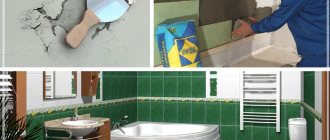Bathroom renovations involve solving many problems for many of our compatriots. The main obstacle to achieving the desired result, turning your fantasies and ideas about beautiful design into reality, is the small area of the room for water treatments. Most standard apartments in our country cannot boast of impressive scale. As a result, owners have to calculate every square centimeter of bathroom space in order to ergonomically arrange all the necessary plumbing fixtures, accessories and storage systems. At the same time, everyone wants to get a beautiful, modern and durable design that would delight all household members with its appearance for many years. The main role in creating a practical and attractive interior is played by the finishing of room surfaces. This publication will be devoted to perhaps the most popular type of design of bathroom surfaces - ceramic tile cladding.
What size tiles should I choose for a small bathroom?
If you take into account a few subtleties, you can lay tiles of any size. To complete the finish, it is advisable to combine different products. But in the end, it all depends on the preferences of the apartment owner, even if it is a small bathroom in a Khrushchev-era building.
- Large products (for example, 30x40) are laid horizontally; this method will visually expand the walls. The grout for the joints should be chosen in a tone so as not to split the space with thin contrasting lines.
- Medium sized tiles (20x30, 30x30) are the best option for a small bathroom.
- Products of small sizes (these include “boar” 10x20 and square 10x10) can split up the space if you use different colors and contrasting grout. It is recommended to choose a single-color material, due to which the room will visually come together.
The photo shows large-format tiles with inconspicuous grout to match.
- Mosaics are usually used to decorate one wall or, for example, a shower stall. If you want to decorate the entire room with mosaics, it should be the smallest and lightest shades in order to create a general background without affecting the geometry.
The photo shows a combined bathroom, the walls of which are decorated with ceramic mosaics interspersed with mirror ones.
Dimensions
For rooms of modest size, it is recommended to select materials that are also small in size. Large items on the wall will look heavy; in addition, rare seams will stand out clearly and disrupt the overall picture. Therefore, to decorate a small bathroom or shower area, you need to choose a small or medium tile size.
There are the following types of wall tile sizes:
100x100 mm. A good option for decorating a bathroom, but it should be noted that material of this size should be selected in light colors (white, beige, light yellow). Otherwise, dark shades will visually reduce the already small space even more.
You can also dilute a plain light wall with splashes of dark tiles that match the tone (for example, choose brown inserts for a light yellow tile).
The disadvantages of this size include the laboriousness of the installation process.
200x200 mm. As in the first case, when choosing tiles of this size, preference should be given to light colors.
It is more convenient to work with 200x200 mm tiles than with 100x100 mm tiles, but the square size does not allow you to visually raise the ceiling, unlike rectangular tiles located vertically.
200x300 and more. Rectangular tiles allow you to get the effect of raising the ceiling when they are laid vertically. This is the optimal size for decorating walls in a small room. To decorate a long and narrow room, the tiles are laid horizontally, which gives the effect of expanding the space.
Also, with low ceilings, it is recommended to arrange vertical stripes of rectangular tiles of a darker shade than the main tone of the wall, which gives the feeling of a higher space.
Recommendations for choosing tile color
Designers do not recommend decorating a small bathroom with products in dark colors. You need to choose neutral shades: white, sand, blue, light green, gray. When combining different colors, it is also recommended to use muted tones.
Products of a rich palette are appropriate as decoration for niches, mirrors, and a bath screen: the choice depends on taste preferences and the layout of the room.
Combination of white and warm shades
This option is suitable for those who want to make their bathroom more comfortable and warm. In this case, you can use not pure white, but shades close to it - cream, beige, almond or ivory.
You can dilute them with brighter colors (rich brown, gold, orange, etc.) or, conversely, with pastel colors (pale pink, peach, light brown or lilac).
Warm shades can also be used in lighting. For example, warm yellowish light will brighten up the white surface of the wall in any case. But the best option is to use hidden lighting for plumbing fixtures, mirrors and furniture.
Selecting the right tile design to increase space
To distract attention from the modest size of the bathroom, designers offer several interesting ideas. For example, you can lay out the same tiles on both the walls and the floor, unifying the space. Or vice versa: make the flooring rich in color - it will draw attention to itself - and decorate the walls in neutral colors. The same technique works with bright furniture and accent elements.
Be sure to look at other ideas for visually enlarging a room.
In the photo, the small bathroom is visually expanded due to the same coating on the wall and floor.
In a small bathroom, you can also combine local areas, for example, a shower room and the floor.
The photo shows compact bathrooms with wide marbled tiles.
Drawing or not?
If the question arises about the patterns on the tiles, then do the following - it’s better to have tiles in your small bathroom with a pattern arranged symmetrically, as if in blots. But don’t put panels on the wall. This tile pattern visually brings the wall on which it is laid closer. This technique visually reduces the space. Therefore, either completely monochromatic tiles, or diluted with patterns on all walls.
An interesting solution - the pictures are slightly lighter than the main tone of the tiles. They create a 3D effect. Another original option is bright colored vertical or horizontal stripes, which can alternate with the main plain tiles. But remember that horizontal stripes make the room wider, and vertical stripes make the room taller.
Another bold and pleasant option is to lay square tiles in several bright colors (blue, yellow, green, orange for example) on the wall. The squares should be arranged asymmetrically, with bright spots. But one shade should still prevail over the others.
Colored tiles on the floor
Interesting: Bathroom tiles: fashion trends 2019
What type of surface to choose: glossy or matte?
Any coating is suitable for a small bathroom, but each has its own characteristics:
| Glossy | Matte |
| Visually increases the area of the room, giving depth. | Used in interiors where gloss is inappropriate. |
| Shiny tiles reflect light, expanding the space. Suitable for walls. | The rough texture of ceramic tiles is safer and therefore suitable for floor coverings. |
| Water drops and handprints are more noticeable on it, but the surface is easy to clean. | On a matte finish, plaque is less noticeable, but it is also more difficult to wash. |
Since the purpose of decorating a small bathroom is to expand the space, glossy products are preferable.
The photo shows a glossy “hog” that adds depth to the space in a small bathroom.
Combination of white and cool shades
Cool colors can also be present in a white bathroom interior. The most common option is blue and deep blue colors. They are often used due to the association of the bathroom with a marine theme and are present in various thematic patterns, images, etc.
USEFUL INFORMATION: Replacing and repairing a siphon under the sink: 5 useful plumbing tips
Another option is green. It will look most successful in combination with warm shades of white. It can be:
- Patterns and inserts on the walls.
- Decor elements.
- Living plants.
The white and green interior is perfect for eco-style apartments.
Which tile shape is best?
The modern market of ceramic tiles is replete with a variety of shapes. But not all options will look good in a small bathroom.
Standard rectangles and squares emphasize the geometry of the room and look unobtrusive: just what you need for a small room. Walls with voluminous, relief or hexagonal tiles look impressive and attract the eye, but you should not overload the space with them.
Check out our bathroom tiling options.
The photo shows rectangular brick-like tiles in a milky shade.
Products of irregular shape (for example, scales) or triangles are suitable only for decorating individual areas.
Laying scheme
The visual perception of the bathroom space depends not only on the type of tile, its color or texture, but also on the method of its installation. Correct application of the laws of design will create the effect of spaciousness, even in a small area:
- traditional installation method without crossing seams. Laying is carried out at right angles without displacement of elements. This option is perfect for installing tiles of various colors in a small room;
- if it was decided to choose a single-color material for the bathroom, designers recommend laying it offset along the horizontal seam by half of the tile;
- Diagonal laying will help increase the volume of a small room, but to install such a finish you will need an experienced craftsman, and besides, after completing such work there are a lot of tile scraps left.
For the traditional direct installation method, you should purchase rectangular tiles and place them vertically. If the room is long and narrow, it is better to lay such tiles horizontally.
How does layout affect a small bathroom?
Here everything depends on the proportions of the bathroom: the layout can lengthen the space or expand it. Long horizontal products expand the walls. The same effect is achieved by lines of contrasting tiles, ceramic or glass mosaics.
Vertically laid tiles visually raise the ceilings.
The photo shows narrow wood-look tiles laid out along the wall.
A diagonal arrangement gives an interesting effect in a small bathroom.
A selection of ideas for a small bathroom
If a plain white bathroom seems boring, you can decorate the border or lay out a pattern with contrasting elements. Bright accents add completeness to the interior. A decor made from parts with a finished pattern would be appropriate.
Be sure to look at how you can tile a toilet.
By combining different colors and textures, you can “dissolve” the extra corners that appear as a result of combining a bathtub and a bathroom. The classic black and white combination looks impressive in the interior of a small bath.
Mosaic tiles
This material is an excellent alternative to white ceramic tiles. Especially if the mosaic combines several different shades with mother-of-pearl tints. With the use of such finishing in modern styles, the bathroom will not look like a hospital ward, and its design will not seem monotonous and boring.
Mosaic with shimmer, bringing life to the bathroom
Mosaic of different shades from snow-white to gray
White mosaic with marble pattern
Glossy mosaic tiles
Golden mosaic in a white bathroom
White mosaic with black grout
White-gray mosaic tiles USEFUL INFORMATION: Installing a siphon on a bath (video): how to properly assemble a bath siphon











